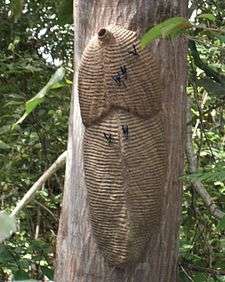Synoeca
Synoeca is a genus of eusocial paper wasps found in the tropical forests of the Americas. Commonly known as warrior wasps or drumming wasps, they are known for their aggressive behavior, a threat display consisting of multiple insects guarding a nest beating their wings[2] in a synchronized fashion, and an extremely painful sting. The sting is barbed and if used often kills the wasp[3], which may be the reason why such a striking defensive display is used. This display escalates from drumming inside the nest to hundreds of wasps moving on to the envelope of the nest and of continuing to drum and only if this does not deter the threat do the wasps begin to sting.[2] Entomologist Justin Schmidt has put the sting of Synoeca wasps high up in the rankings on his Schmidt sting pain index and has described it as "torture. You are chained in the flow of an active volcano."
| Synoeca | |
|---|---|
_on_their_nest_..._(28918674181).jpg) | |
| Synoeca cyanea on their nest | |
 | |
| S. septenrionalis nest | |
| Scientific classification | |
| Kingdom: | Animalia |
| Phylum: | Arthropoda |
| Class: | Insecta |
| Order: | Hymenoptera |
| Family: | Vespidae |
| Subfamily: | Polistinae |
| Tribe: | Epiponini |
| Genus: | Synoeca de Saussure, 1852 |
| Type species | |
| Vespa surinama | |
| Species | |
|
6 described species | |
A research team in Brazil has discovered that Synoeca stings contain a newly discovered compound that could be used to treat anxiety, apparently working as effectively as diazepam when tested on rats.[4]
Distribution and habitat
The genus has a wide range within the Americas, with specimens being found in the tropical and subtropical portions thereof. S. septentrionalis is generally found in the northern part of the range, having been observed as far north as Mexico, throughout Central America and northern South America; the southern part of its range extends into Brazil. The other species in the genus are predominantly found in South America, as far south as Argentina.[5] Synoeca thrives in tropical rainforests, building arboreal nests in trees, typically on the underside of major branches. A single comb is built directly on the tree trunk; and the nests have a characteristic shape which resembles an armadillo, leading to common vernacular names such as marimbondo-tatu or armadillo wasp.[6] These wasps swarm to form new colonies, a single queen leaves the nest accompanied by some workers to a new nest site. The queen uses pheromones to suppress the reproductive behaviour of the workers. When one queen dies she is replaced by another; colonies may last up to 16 years.[2]
Species
- Synoeca cyanea Fabricius, 1775
- Synoeca chalibea de Saussure, 1852 (often misspelled as chalybea)
- Synoeca ilheensis Lopes & Menezes, 2017[7]
- Synoeca septentrionalis Richards 1978
- Synoeca surinama Linnaeus 1767
- Synoeca virginea Fabricius, 1804
References
- O.W. Richards (1978). The social wasps of the Americas excluding the Vespinae. The British Museum Natural History. p. 178. ISBN 0565007858.
- Hogue, Charles Leonard (1993). Latin American Insects and Entomology. University of California Press. ISBN 0-520-07849-7.
- Hermann, Henry (1971). "Sting Autotomy, a defensive mechanism in certain social Hymenoptera". Insectes Sociaux. 18: 111–120. doi:10.1007/bf02223116.
- Greta Friar (4 November 2016). "The Venom of This Dangerous Wasp Could Someday Help Treat Anxiety". Nova Next. WGBH Educational Foundation. Retrieved 25 November 2016.
- Andena, Sergio R.; Carpenter, James M.; Noll, Fernando B. (2009). "A phylogenetic analysis of Synoeca De Saussure, 1852, a neotropical genus of social wasps (hymenoptera: vespidae: epiponini)". Entomologica Americana. 115 (1): 81–89. doi:10.1664/07-ra-002r.1.
- Rodolpho S. T. Menezes; Sergio R. Andena; Antonio F. Carvalho; Marco A. Costa (2011). "First records of Synoeca septentrionalis Richards, 1978 (Hymenoptera, Vespidae, Epiponini) in the Brazilian Atlantic Rain Forest". ZooKeys. 151: 75–78. doi:10.3897/zookeys.151.1882. PMC 3286226. PMID 22368453.
- Rogério B.Lopes; Rodolpho S.T. Menezes (2017). "Synoeca ilheensis sp. nov., a new social wasp (Hymenoptera, Vespidae, Polistinae) from Brazilian lowland Atlantic Forest (abstract)". Zootaxa. 4300 (3): 445. doi:10.11646/zootaxa.4300.3.8.